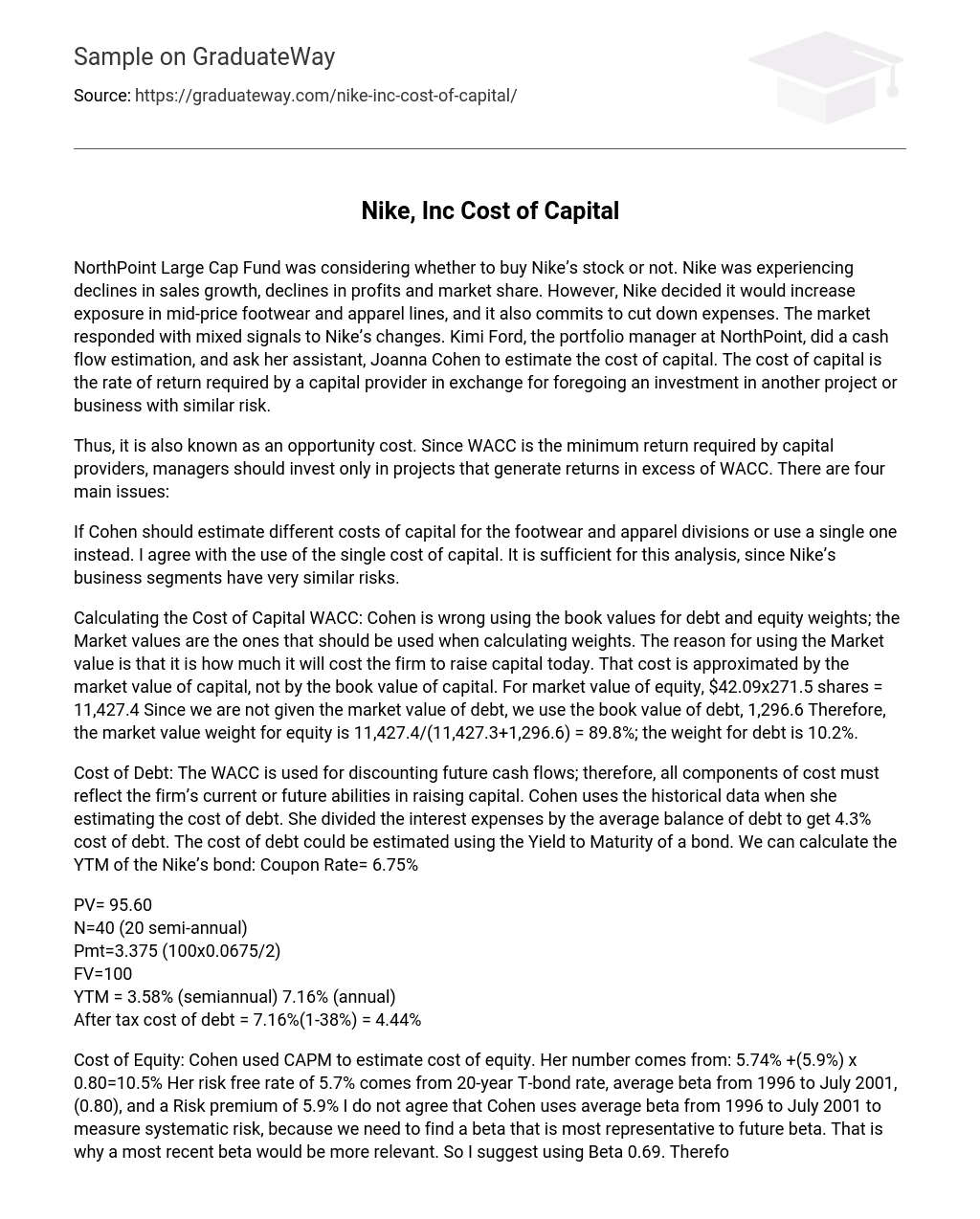NorthPoint Large Cap Fund was deliberating on whether to purchase shares of Nike. Despite Nike facing declining sales growth, profits, and market share, the company resolved to enhance its presence in mid-priced footwear and apparel lines, while also committing to expense reduction. The market’s reaction to Nike’s initiatives was a mixture of positive and negative signals. In light of these developments, Kimi Ford, the portfolio manager at NorthPoint, conducted a cash flow estimation and requested her assistant, Joanna Cohen, to determine the cost of capital. Such a cost represents the return rate expected by a capital provider in return for forgoing an investment in another project or business with comparable risk.
The term “opportunity cost” is used to refer to the WACC. The WACC is the minimum return that capital providers require. Therefore, managers should only invest in projects that generate returns higher than the WACC. There are four key issues to consider:
If Cohen should determine varying costs of capital for the footwear and apparel divisions or opt for a single one. I support the use of a single cost of capital. It is adequate for this analysis because Nike’s business segments possess comparable risks.
Calculating the Cost of Capital WACC: Cohen’s incorrect approach to calculating debt and equity weights using book values is countered by the argument that market values should be used instead. This is because the market value represents the current cost for the firm to raise capital. The market value of capital, rather than the book value, provides an estimate for this cost. To calculate the market value of equity, we multiply $42.09 by 271.5 shares, resulting in 11,427.4. Since there is no given market value for debt, we utilize the book value of debt, which is 1,296.6. Subsequently, the market value weight for equity equates to 11,427.4 divided by the sum of 11,427.3 and 1,296.6, amounting to 89.8%. Conversely, the weight for debt is 10.2%.
The WACC is utilized to discount future cash flows, so all aspects of cost must align with the firm’s current or future capacities for raising capital. Cohen relies on historical data when estimating the cost of debt, dividing interest expenses by the average debt balance to arrive at a 4.3% debt cost. Alternatively, the cost of debt can be approximated using the Yield to Maturity (YTM) of a bond. To calculate Nike’s bond YTM, the Coupon Rate is 6.75%.
PV = 95.60
N = 40 (20 semi-annual)
Pmt = 3.375 (100×0.0675/2)
FV = 100
YTM = 3.58% (semiannual) 7.16% (annual)
After tax cost of debt = 7.16% (1-38%) = 4.44%
Cost of Equity: Cohen used CAPM to calculate the cost of equity. Her calculation is as follows: 5.74% + (5.9%) x 0.80 = 10.5%. The risk-free rate of 5.7% is derived from the 20-year T-bond rate, the average beta from 1996 to July 2001 (0.80), and a risk premium of 5.9%. However, I disagree with Cohen’s use of the average beta from 1996 to July 2001 to gauge systematic risk. It would be more appropriate to use the most recent beta as it will better represent future beta. Hence, I suggest utilizing a beta of 0.69. Consequently, the revised cost of equity would be:
The sum of 5.74% plus 5.9%, multiplied by 0.69, equals 9.81%.
Combining all the pieces:
My calculation of the Weighted Average Cost of Capital (WACC) is:
0.0444 x 0.102 + 0.0981 x 0.898 = 9.26%
The revised Cost of Capital/WACC will impact the terminal value of FCF 2011. The new FCF will amount to 27,449.4, calculated as 1,572.7 x (1+0.03)/0.0926-0.03 which yields 25,876.7. Consequently, the NPV is now $17,109.14.
The calculated new price is $59.36, which is higher than the current market price of $42.09, indicating that it is undervalued. As a result, the recommendation is to BUY!





